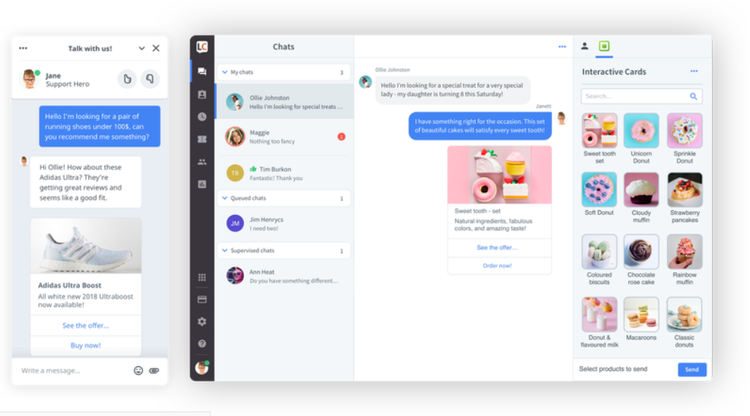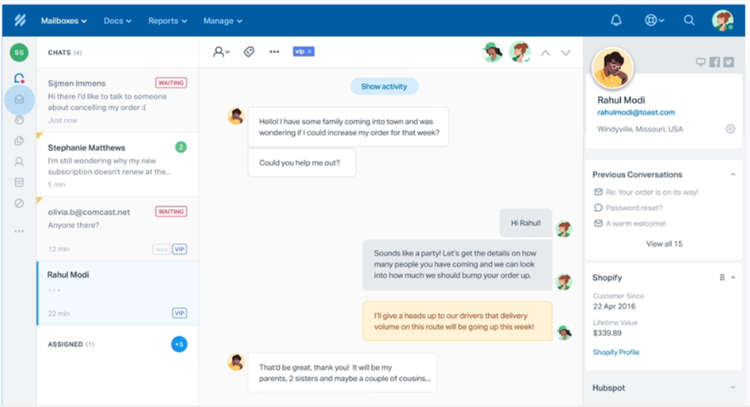9 Help Desk Best Practices to Improve Your Customer Support
There are plenty of statistics demonstrating the importance of good customer service. One study found that 33% of Americans would consider switching companies over just one bad customer service interaction.
U.S. companies lose $62 billion each year due to poor customer service, and seven in 10 U.S. consumers say they spend more on companies that provide great service. The list goes on and on.
As a result, it would behoove you and your company to make sure that when your customers contact you with an issue, they'll leave satisfied and tell their friends about what a great experience they had.
But customer service is challenging in the best of circumstances, and even the most seasoned managers struggle to get it right.
If you want to improve the customer experience, here are nine best practices to implement right away.
The 9 help desk best practices to improve your customer support.
- Don't just hire anyone
- Hire enough people
- Assign the right people to the right tickets
- Use automation and canned responses
- Don't go overboard with automation
- Use multiple channels
- Create a knowledge base and self-service portal
- Solicit customer feedback
- Use software
1. Don't just hire anyone
Resist the urge to grab the first person who submits a decent resume and throw them into help desk support. More than just about any other work, customer care is a special job requiring a certain touch, so you must carefully interview applicants to determine if they’re the right fit.
Making the wrong choice means unhappy customers, and you can't afford that. Look for applicants with empathy, listening skills, a positive attitude, the ability to adapt and make decisions on the fly, and -- most of all -- patience.
2. Hire enough people
Another temptation is to try to do too much with too little. You need proper staff to take care of customer service requests. If you don't hire enough people to handle the job, you'll have rushed support calls and delayed responses, which lead to unhappy customers.
Do not underestimate the importance of customer service. Zappos built an online shoe and clothing retail empire mostly through exceptional customer service, and many other companies pour a huge amount of money into their customer service teams for good reason.
If your team is struggling to keep up with customer service requests, get them some more help.
3. Assign the right people to the right tickets
Your customers' support requests often cover a wide range of problems. Sometimes they have specialized customer needs that most of your support team members are unable to handle.
You must have a system in place that allows you to funnel specialized ticket requests to people who have the expertise to answer them without frustrating the customer.
For example, if you sometimes have customers calling with complicated IT server maintenance issues, and your IT help desk support mostly deals with initial setup, have ITIL service desk analysts on standby who can personally handle those customers.
4. Use canned responses
Your customers' time is valuable, but so is your customer service team's time, so you must limit repetitive calls as much as possible.
You'll find that customers call and ask the same question, so develop some canned responses your team can use in each situation. This not only saves them time, and it also allows you to custom-tailor a satisfactory response for your customers, who will be happier as a result.
5. Don't go overboard with automation
If you have an automated system for handling customer service calls, avoid trying to handle everything through this service. Your customers will be fine with automation to a point, and many will even be grateful since it helps them solve their problems faster.
But when they want to talk to someone and you don't offer an obvious way to do it, you’ll be dealing with angry customers, and you don't want that.
Use automation as a sorting method for your customers rather than something that's supposed to solve all of their problems without talking to your support desk. Use an automation system to get customers to the right person who can quickly and personably answer their questions.
6. Use multiple channels
Customers like to communicate in different ways -- some prefer a phone call, others like email, and still more are happy poking around your website for the answers. As a result, you should offer multiple channels for your customers to contact you.
A phone number or email address is the most obvious way to provide your customers with access to your support team, but you should also look into live chat software or a support ticket system.

LiveChat allows your customer support team to manage chats with customers. Image source: Author
7. Create a knowledge base and self-service portal
Sometimes your customer doesn't necessarily want to talk to a member of your team. If they can find the answer on their own, that's just fine by them (also, that support may be available 24 hours per day).
As a result, you should provide an in-depth knowledge base and self-service portal so they can solve problems on their own. This not only increases customer satisfaction, but it also takes a lot of the load off your support staff.
8. Solicit customer feedback
The truth is you really don't know how well your customer support team is performing until you hear from your customers. Solicit feedback by sending your customer base surveys to gauge how they regard your customer support and what you could do to improve.
The voice of the customer is invaluable information that will help you take your customer support to the next level and avoid wasted effort on your part.
9. Use software
Customer service software offers so many powerful tools that will help you increase the efficiency and effectiveness of your customer support. Automation tools will handle much of the busywork that ties up your team's time so they can focus on handling customer issues.
Help desk metrics and analytics tools will help you take a deep dive into the data to spot any concerning trends and make adjustments that will improve performance.
And help desk software will keep your team more organized and provide them with access to the information they need to properly handle customer queries.

Help Scout manages interactions with customers like an email inbox. Image source: Author
Does your customer service system need an overhaul?
If you’re struggling with customer retention and suspect that your customer service system is not up to par, it’s time to find out for sure. Have a discussion with your team to determine if they feel overwhelmed and if they’re confident in their ability to handle customer queries.
Take a day to monitor customer service calls to get a sense of how they are handled. And send a survey out to your customer base to find out what they think of your customer service and how it can be improved.
Once you’ve conducted this audit, you should have all the necessary insights to develop a new customer service system and staff it with the right people. Don’t put off doing this -- the longer you wait, the more customers you risk losing.
Alert: our top-rated cash back card now has 0% intro APR until 2025
This credit card is not just good – it’s so exceptional that our experts use it personally. It features a lengthy 0% intro APR period, a cash back rate of up to 5%, and all somehow for no annual fee! Click here to read our full review for free and apply in just 2 minutes.
Our Research Expert
We're firm believers in the Golden Rule, which is why editorial opinions are ours alone and have not been previously reviewed, approved, or endorsed by included advertisers. The Ascent does not cover all offers on the market. Editorial content from The Ascent is separate from The Motley Fool editorial content and is created by a different analyst team.
Related Articles
View All Articles